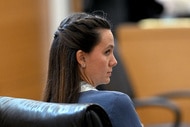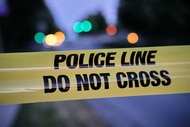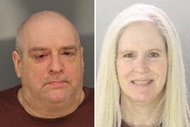Create a free profile to get unlimited access to exclusive videos, breaking news, sweepstakes, and more!
What Happened To Helena Stoeckley, The Woman Who Confessed To Witnessing The Jeffrey MacDonald Family Murders?
Helena Stoeckley repeatedly confessed--and then recanted--being in the home of Jeffrey MacDonald the night his pregnant wife and two young daughters were brutally killed.

The complex case of Jeffrey MacDonald and the gruesome murders of his pregnant wife and two young daughters has been increasingly complicated over the years by one woman.
Helena Stoeckley—a drug-addicted hippie who lived in Fayetteville, North Carolina at the time of the slayings—has repeatedly claimed that she was in MacDonald’s home the night of the murders with a group of friends who carried out the brutal attacks, even after MacDonald himself was convicted of the murders in 1979.
Her story has continually changed over the years—with Stoeckley claiming at times that she had been in the home on Feb. 17, 1970 when Colette MacDonald and her daughters, 5-year-old Kimberley and 2-year-old Kristen, were viciously killed, while at other times saying she either hadn’t been in the home or had no recollection of her activities that night.
Investigators quickly dismissed Stoeckley, who had been a teenaged confidential police informant at the time of the murders, as unreliable and they focused instead on evidence they said pointed to Jeffrey MacDonald, a Green Beret surgeon with an Ivy League education.
More than 50 years after the slayings, MacDonald continues to proclaim his innocence from behind bars—pointing to Stoeckley’s past confession as evidence that he didn’t carry out the crime.
So what happened to Stoeckley in the years that followed?
Stoeckley died in 1983 at the age of 30 of acute pneumonia and cirrhosis of the liver in her South Carolina apartment, according to a 1998 Vanity Fair article.
But not before making one last confession to her mother just three months before she died.
“She told my mother she was there that night and that Dr. MacDonald was innocent,” her brother Gene Stoeckley told People in 2017. “I know my mom in her heart believed it. ... My sister knew her time was short — she had cirrhosis. The prosecution used the fact she was affected by drug abuse over the years, but my sister had no reason to make things up or lie.”
The Gruesome Crime
Jeffrey MacDonald told investigators he had been asleep on the living room couch in the early morning hours of Feb. 17, 1970 when he was awakened by his wife screaming and saw four people—two white males, a Black man wearing an Army jacket, and a woman with long blonde hair, a floppy white hat and knee-length white boots—inside the home, according to the new FX docuseries “A Wilderness of Error,” which reexamines the case.
MacDonald, who said the woman was chanting “Acid is groovy” as she held a candle, told Army investigators that he tried to fight off the attackers but his pajama top got pulled over his arms.
“All of a sudden it was in my way and I couldn’t get my hand free,” he said in his interview with investigators, according to the docuseries. “I was grappling with him and I saw, you know, a blade. I really didn’t even defend myself. It was too fast and all this time I was hearing screams.”
MacDonald said the next thing he remembered he was lying in the hallway. He got up and went into the master bedroom, where he discovered his wife had been stabbed to death. After stumbling into his daughters’ rooms, he discovered his children had met the same fate. MacDonald said he managed to call 911 before collapsing next to his wife, where he was discovered by military police.
Authorities would later determine that Colette MacDonald had been stabbed 16 times with a knife, 21 times with an ice pick and hit in the head with a piece of wood at least six times, according to the Fayetteville Observer.
Kimberley was hit twice in the head and stabbed somewhere between eight and 10 times; her younger sister, Kristen, had been stabbed 17 times and had 15 puncture wounds to her chest, the paper reported. She also had defensive wounds to her hands.
“It was the worst thing in my 53 years in law enforcement that I have ever walked into. A gruesome scene to see a mother and two daughters mutilated like they were and it’s a scene that you ain’t gonna ever forget,” John Hodges, who had worked in the criminal investigation division, said in the FX series.
But while all three victims suffered dozens of wounds, MacDonald’s most severe injury was puncture wound to the chest and a partially collapsed lung.
The Woman In The Floppy Hat
Hodges said that after MacDonald’s description of what happened, investigators
“rounded up a bunch of hippies” living in Fayetteville that resembled the descriptions MacDonald had given—but it didn’t yield any promising leads.
“None of them denied they were on drugs, but they all denied having anything to do with the murders or knowing anybody fitting the descriptions,” he said in the docuseries.
Stoeckley, who was 18 at the time, was linked to the case after Fayetteville Police Det. Prince Beasley said that one of his drug informants resembled the description MacDonald had given of the woman in the floppy hat.
“I had seen Helena on many occasions with these other people that Dr. MacDonald gave the description of,” he said in the docuseries.
Beasley said the night after the crime, he staked out Stoeckley’s home and approached her after he saw her drive up around 2 a.m. with “all these guys that MacDonald had described.”
“I bluntly asked her, I said, ‘I know you’ve heard about the murders out at Fort Bragg. The descriptions fit you people perfectly. Were you there? Answer yes or no.’ She told me that she was on drugs, but yes, she thought she was there,” he said.
But there have been conflicting accounts of Beasley’s initial conversation with Stoeckley about the murders. According to the 1998 profile of the case in Vanity Fair, Beasley had gone to Stoeckley’s home because, as his principal informant, he wanted to know if she knew of anyone who fit the description. She provided a few addresses and told him about a Black friend that she would shoot up heroin with sometimes who also wore an Army jacket. The article claims that Beasley never asked Stoeckley about her own whereabouts during that meeting.
Bill Ivory, who worked in the criminal investigation division at the time of the murders, said in the docuseries that Beasley contacted the military and he interviewed Stoeckley shortly after the murders but there was “no information that would tie her to the case” and she lacked basic knowledge, including the address of the home.
“It just added more to the confusion,” he said.
Inconsistent Confessions
Stoeckley’s role in the high-profile case wouldn’t end there.
She was arrested a short time later in Nashville for drug possession and allegedly admitted to having a role in the slayings.
“We were on patrol one night here in Nashville and we just happened to see this woman,” former Nashville police officer Jim Gaddis said in the docuseries. “She wore this black cape with red lining, a wig and a floppy hat. She’d just sort of float around.”
She was arrested for drug possession and allegedly divulged she had a hand in the MacDonald family murders on the way to booking.
“Helena described the house to a T, she knew how the doctor was laying on the couch, where the kids were, what bedroom and she gave us names of officers she had talked to in Fayetteville,” Gaddis said, later adding that he believed she was “guilty as sin.”
Beasley said he went to Nashville to talk with Stoeckley after being contacted by Nashville police.
“She told me in depth that she did not tell all that she knew about this case because if she did, she would go to prison,” he said in a previous interview.
The Army sent polygraph expert Robert Brisentine to administer a polygraph on Stoeckley, but she provided inconsistent statements about her involvement.
“During our conversation, she would tell me one minute she was there when the family was killed and the next minute, she’d tell me, ‘No, I wasn’t there’,” he said in the series.
The polygraph showed deception, but her actual involvement in the crime remained unclear.
“She didn’t know whether she was there or not,” he said. “What we have here is a gal who's screwed up. You could never call her a liar, but you can’t call her a truth-teller either.”
Stoeckley would later claim in a 1982 interview with Ted Gunderson, a former FBI official and author who joined MacDonald's defense team as an investigator, that the polygraph test “was a set-up.”
“I was busted on narcotics in Nashville, Tennessee and they told me if I would agree to take the polygraph because I had been avoiding the police and everything else—which is contrary to everyone saying I was after publicity and attention and everything else. They told me at that time, if I would take the polygraph that they would drop the mescaline charge,” she said. “I had $25,000 worth of mescaline, so I would have been a fool to deny that.”
A Troubled Life
Stoeckley also had a history of credibility problems. Former classmates described Stoeckley to investigators as a sad, disturbed girl who often made up stories to get attention, according to Vanity Fair.
A psychiatrist who worked at a hospital where Stoeckley had sought help for drug addiction described her on a discharge form as someone with a “schizoid personality” who regularly partook in heroin eight or nine times a day along with a mix of other drugs. He listed her prognosis as “poor.”
Her younger brother, Gene Stoeckley, told People her life had not always been that tragic. He described an idyllic upbringing until she began using drugs.
“She was always upbeat,” he said. “She had so much talent singing and playing piano. She got singing lessons from a member of the Fayetteville symphony.”
She fell in with the wrong crowd after she started spending time at Fayetteville pizza parlor known to be a hangout for drug dealers during her final year of high school. Her father, a retired Army colonel, kicked her out of the house when he discovered her using drugs.
“According to mom, a detective with the Fayetteville police approached her and asked her to funnel them information,” Gene told the outlet. “It sounded like she agreed, decided to play the part and became more and more involved. She was doing a good thing. She let herself be taken in so deep it had a hold on her. It was her downfall.”
According to Gene, Stoeckley also became fascinated with the occult and had a black cat she named Satan.
Focusing On MacDonald
Investigators believed the evidence at the crime scene suggested there had been no outside intruders at the home that night and pointed to a source much closer to home: Jeffrey MacDonald.
MacDonald was ordered to appear before an Article 32 hearing, a military process used to determine whether there was enough evidence to pursue charges in the case, after finding blood evidence they believed linked the doctor to the killings.
The colonel presiding over the hearing ultimately dismissed the allegations against MacDonald, but recommended that “appropriate civilian authorities” investigate Stoeckley’s claims further, according to Vanity Fair.
MacDonald breathed a sigh of relief and moved to California to set up a new life for himself, but his father-in-law Freddy Kassab was determined to find justice for his slain stepdaughter and slowly became convinced of MacDonald’s guilt after his own investigation.
He continued to hound authorities until MacDonald was eventually charged with murder and stood trial in 1979.
His defense team, led by Bernard Segal, hoped Stoeckley would provide an alternative explanation of what happened that night, but when she was called to the stand to testify under oath, she said she had no recollection of what she had been doing the night the MacDonald family was killed.
Six witnesses took the stand to swear that Stoeckley had told them she had been in the house that night, but the jury would never hear the testimony after Judge Franklin Dupree ruled that Stoeckley was “untrustworthy” and a “tragic figure” who had made most of her statements while heavily under the influence of drugs.
The controversial decision not to let the jury hear the potential witnesses in the case has drawn skepticism from some, including Errol Morris, an American filmmaker and author who wrote the book “A Wilderness of Error” in 2012. The book served as the inspiration for FX’s docuseries.
“I would say that Helena Stoeckley confessed to no fewer than a dozen people in the week leading up to her appearance on the witness stand in 1979. The jury, however, heard none of it,” Morris told The Atlantic in 2013. “I don't know for certain if Stoeckley was in MacDonald's house on the night of the killings. But her repeated confessions are real evidence, and should have been heard by the jury.”
MacDonald was convicted of three counts of murder in 1979 and remains behind bars today, more than 50 years after his family was killed.
Stoeckley Claimed ‘Satantic Cult’ Killed The Family
MacDonald’s conviction didn’t put an end to Stoeckley’s claims that she had been in the home. In 1982, she sat down with Gunderson and Beasley in a taped interview, claiming that she had been part of a “satanic cult” that had killed the family because MacDonald was “not cooperative” in helping heroin addicts during his time at Fort Bragg.
“He was more interested in working with people on hallucinogenic and things like that. He just wouldn’t cooperate with us at all,” she said.
On the night of the killings, she claimed the group had “no discussion of murder at all” but had planned to go to his home to “make him realize he had to help us with something like that.”
She told Gunderson she remembered being inside the home and chanting while she was under the influence of drugs.
“I chanted, ‘Acid is groovy. Kill the pigs. Hit him again, or something like that,’” she said, claiming that there had been a total of seven people from the group in the home.
Stoeckley also provided a signed statement to authorities claiming to have witnessed the murders. Gunderson later turned the evidence over to authorities, according to a 1982 article in the New York Times.
The statements obtained by Gunderson, however, have drawn some criticism over the years.
Homer Young, an ex-FBI agent who had been assisting Gunderson, later told authorities he believed there had been “an element of duress” in Stoeckley’s interview and that “unethical means” had been used to gain her cooperation, Vanity Fair reports.
Stoeckley, who was pregnant at the time, had allegedly been told she’d be relocated to California with a new identity and believed there would be a movie deal in the works, according to Vanity Fair.
Beasley had also been hoping to benefit from the story by agreeing to help with a book being written by Fayetteville Times reporter Fred Bost after suffering his own set of personal setbacks, the outlet reports. Beasley was found passed out drunk in the middle of an intersection by state police and was then forced to retire from the force. He was hospitalized in a V.A. facility and diagnosed with “non-psychotic organic brain syndrome” which could cause “confusion” or making up stories.
The same month Stoeckley sat down for the interview she traveled to visit her mother and made one last confession.
Her mother, also named Helena Stoeckley, later described the confession in a 2007 affidavit filed by MacDonald’s attorneys as part of a federal appeal, according to The Associated Press.
The elder Stoeckley wrote that her daughter “told me she could no longer live with the guilt of knowing she had been in the house but lied about it at the trial.”
Stoeckley died three months later of acute pneumonia and cirrhosis of the liver in her South Carolina apartment.



























